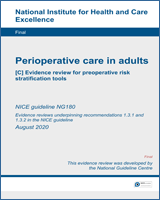From: Evidence review for preoperative risk stratification tools

NCBI Bookshelf. A service of the National Library of Medicine, National Institutes of Health.
| Review question | All questions – health economic evidence |
|---|---|
| Objectives | To identify health economic studies relevant to any of the review questions. |
| Search criteria |
|
| Search strategy | A health economic study search will be undertaken using population-specific terms and a health economic study filter – see appendix B below. |
| Review strategy | Studies not meeting any of the search criteria above will be excluded. Studies published before 2003, abstract-only studies and studies from non-OECD countries or the USA will also be excluded. Each remaining study will be assessed for applicability and methodological limitations using the NICE economic evaluation checklist which can be found in appendix H of Developing NICE guidelines: the manual (2014).115 Inclusion and exclusion criteria
Where there is discretion The health economist will make a decision based on the relative applicability and quality of the available evidence for that question, in discussion with the guideline committee if required. The ultimate aim is to include health economic studies that are helpful for decision-making in the context of the guideline and the current NHS setting. If several studies are considered of sufficiently high applicability and methodological quality that they could all be included, then the health economist, in discussion with the committee if required, may decide to include only the most applicable studies and to selectively exclude the remaining studies. All studies excluded on the basis of applicability or methodological limitations will be listed with explanation in the excluded health economic studies appendix below. The health economist will be guided by the following hierarchies. Setting:
Health economic study type:
Year of analysis:
Quality and relevance of effectiveness data used in the health economic analysis:
|
From: Evidence review for preoperative risk stratification tools

NCBI Bookshelf. A service of the National Library of Medicine, National Institutes of Health.